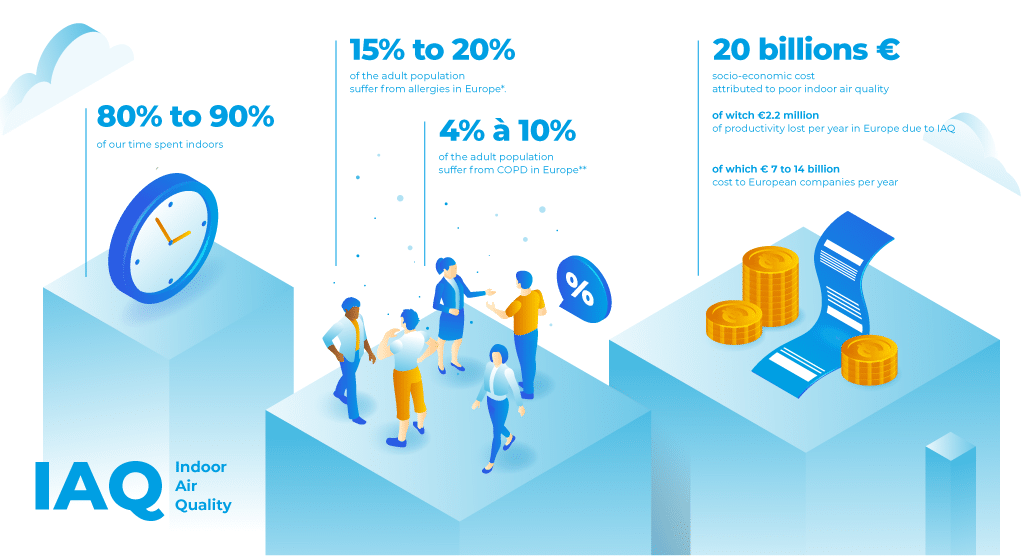The Challenges of Indoor Air Quality
The relationship between Indoor (and Outdoor) Air Quality, HVAC (Heating, Ventilation and Air Conditioning) systems and occupant health are closely linked. Indoor air quality is at the heart of all debates, knowing that
we instead 90% of our time in confined spaces.
This invisible pollution is a major environmental healthproblem. Poor air quality can cause headaches, fatigue, problems with concentration, rashes and irritation of the eyes, nose, throat and lungs.

Corporate Social Responsibility (CSR) objectives
- Health, comfort and well-being of the occupants
Quality of life and air quality are intimately linked. Beyond the feeling, headache, dryness, tingling and nasal congestion are the immediate effects of poor indoor air quality on occupants.
- Preventing risks
Many chronic diseases (COPD, asthma, allergies) are directly attributable to inappropriate long-term aerial environments
An EconomicGame
- Increase performance and productivity & decrease absenteeism
Drowsiness, sore throat, rhinitis… Whether it impacts individual performance or absenteeism, poor air quality is a limiting factor in the company's productivity.
- Three approaches to solving a health problem
There are three approaches to solving a health problem: Reactive, Preventive and Predictive.
- The Reactive Approach benefits from experience for an optimal response
- The Preventive Approach has a generally lower health and economic cost.
- The Predictive Approach attempts to optimize the response by taking the best of the other two. Predictive maintenance of aeraulic networks, for example, is a new source of optimization.
A Health Challenge
- An aggravating factor
TheWHO has recognized for several years poor air quality as a major aggravating factor in many diseases(stroke, heart disease, respiratory diseases, etc.) 7 million premature deaths are thus attributable in part to poor air quality.
- Chronic and systemic exposure
According to the WHO, 91% of the world's populationlives or frequents places with pollutant levels above the guide values. Indoor air pollution is just as concerned as the pollution mists of large cities.
- The most vulnerable are the most affected
Almost half of all infant mortality from pneumonia is directly attributable to poor air quality, including kitchen soot and smoke. The elderly or those with breathing difficulties are also more exposed to the consequences of poor air quality.
IAQ, the first steps of regulation in France

Air quality is an international topic. World Health Organization (WHO) air quality guidelines assess the effects of air pollution and give threshold values above which it is harmful to humans.
In France, the Labour Code and ANSES give us threshold values (VLEP) to respect.
Since 2018, the Grenelle 2 Decree has come into force for all LES (Establishment Receiving the Public), in 3 main stages in order to raise public awareness of indoor air quality.
In Belgium, the Code of Occupational Welfare gives us threshold values for indoor air quality in workplaces.
In Dubai, threshold values are given by the Dubai Municipality.

